 https://vimeo.com/519278520/28caff1c8c
https://vimeo.com/519278520/28caff1c8cWhen to Choose this Retro
This format is super simple, takes almost no prep work, and can be facilitated with almost any toolset. It’s a great alternative to many of the popular quick retrospective formats out there (like start/stop/continue) since it follows the Focused Conversation structure but in a very light touch way. (Learn more about the Focused Conversation structure when you purchase the full course).
Buy The Full CourseWe use it instead of the timeline retro when the Sprint or other retrospective timeframe is shorter or nothing particularly notable happened late in that timeframe, which would cause us to use the timeline retro to neutralize recency bias. So when the timeframe is short and/or the team can easily remember what happened over the full timeframe, this simple ORID retro is a great way to get right into the meat of your discussion.
For example, many of our clients launch a team using 1-day sprints. This retro format is great when you only want to spend 15 minutes at the end of the day reflecting on the previous 24 hours.
It’s also great for teams who work very closely together every day. They’re going to have more shared data, so they don’t need to do the observation and reflection stages as slowly and deliberately.
The Miro Board
You can find a view-only copy of the Miro board for this retrospective here: https://miro.com/app/board/o9J_leCBUyU=/
If you have a paid Miro account, you can import this backup of the board:
Lightweight-ORID-Retrospective.rtbDownload
Check out the Miro help center for instructions on importing a board backup if you’ve never done that before: https://help.miro.com/hc/en-us/articles/360017572774-Board-Backup
Preparation
When you schedule this retrospective, you probably need either 30, 60, or 90 minutes:
- 30 minutes may be sufficient if you’re reflecting on a period shorter than a week, especially if the team was working closely together
- Schedule at least 60 minutes if you are reflecting on a time frame that is a week or longer. You may not use all 60 minutes, but finishing early is better than running out of time.
- Schedule 90 minutes if you are reflecting on multiple weeks, or you suspect that there will be some tough conversations or difficult decisions to make. While 90 minutes might look long on the calendar, if the time is used well and you can get to some breakthrough improvements, it is well worth that extra time.
Pro tip: Schedule your meeting to start at 2, 7, 32, or 37 minutes after the hour. Most people are over-scheduled these days, jumping from one meeting to another. Starting yours a little later than others, but at a precise time, is a great way to increase your chances of starting on-time with everybody in the meeting. This gives you more energy going into your retro.
Make a copy of the Lightweight ORID Retrospective Miro frame. Some teams choose to keep all their retros in the same Miro board. Others create a new board for each one.
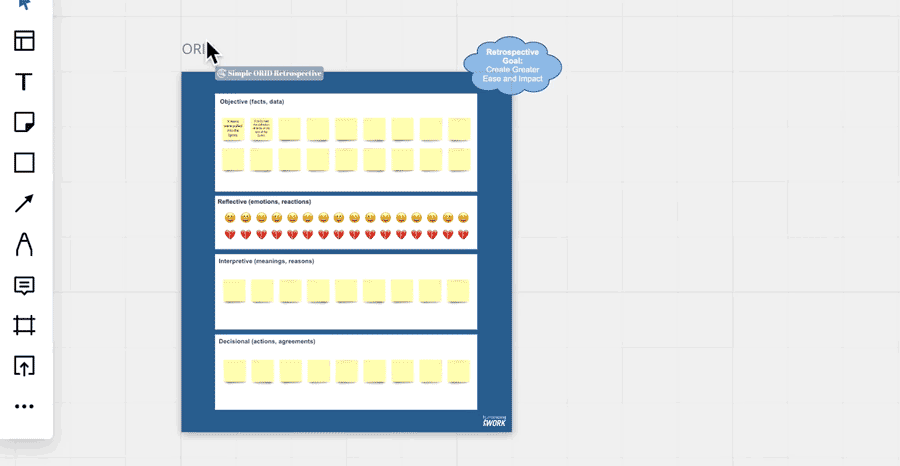
Pre-populate the Objective section of the retro frame with any data you have that might be useful for the team. For example, you might capture how many items were pulled into the sprint and how many were completed. Data doesn’t have to be text on sticky notes. For example, you might add the team’s burndown chart or cumulative flow diagram as part of the data.
Include data about outcomes of the previous retrospective and what happened with them since then.
Take care to ensure that any data you put on the board is clearly objective. Remove any judgmental language. Only add items in advance that you’re certain everyone on the team would agree did indeed happen. Save anything debatable to offer during the course of the retrospective. If you offer the team what feels like biased data at the start of the meeting, you undermine your credibility as the facilitator.
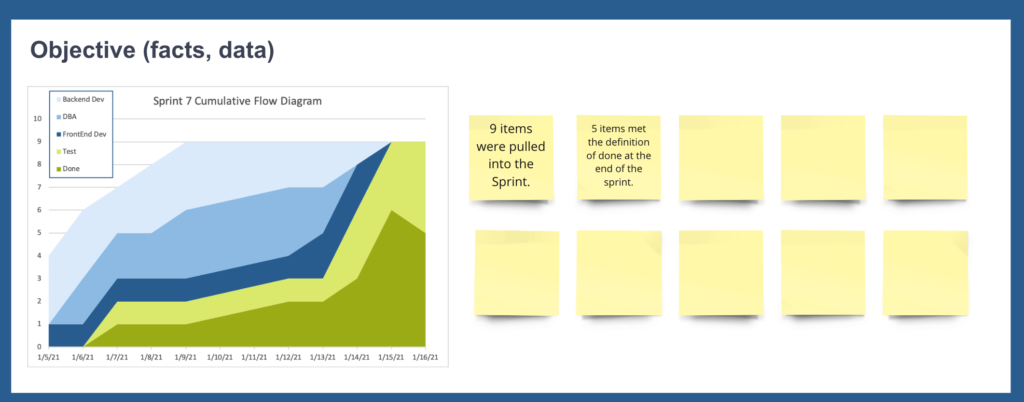
Count the reflection icons (the smiley faces and broken hearts) to make sure there’s one of each for each participant. Duplicate or remove icons if needed to give every participant one and only one of each.
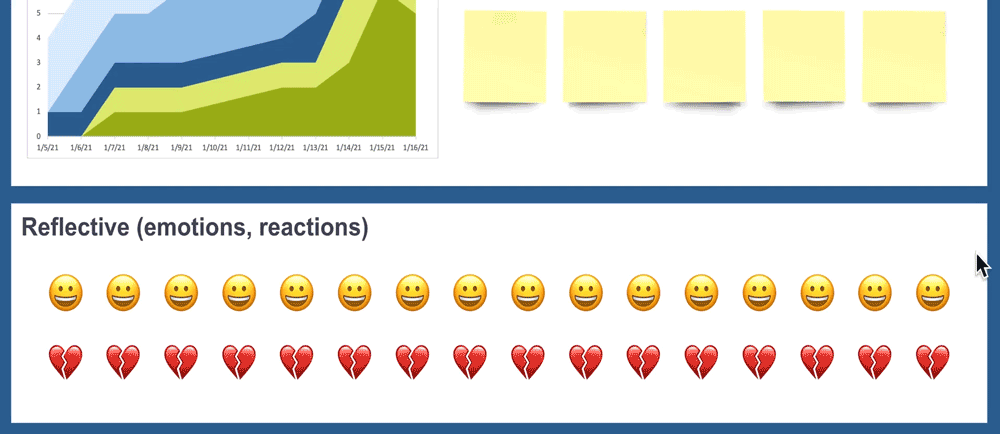
Opening
This is a quick, focused retro format, so you’ll want a high-energy opening to set the tone. Refer back to the Start Strong lesson for advice on planning a good opening. (Learn more about the Starting Strong when you purchase the full course).
Buy The Full Course ($200 off for a limited time!)We’ve added a thought bubble that you can use here with our favorite retrospective framing. You might refer to this graphic and say:
“As always, our goal for this retrospective is to arrive at some specific ways that we can create greater ease and impact”
Observation
Use the “say it then write it” brainstorming approach here. Invite participants to add observations about what happened by saying out loud what they want to write and then capturing it on a sticky note. While the first participant is writing, invite another to share. Continue until the ideas slow down or begin to repeat. At that point ask, “What else happened that hasn’t yet been captured in some form?”
Reflection
Next, say something like: “Now we want to capture your reactions to what happened. Look over the data on the board. Think back over how it felt during the sprint. Drag a smiley face icon onto the item you’re most happy about or that you found most motivating. Drag a broken heart icon onto the item that’s most frustrating or demotivating for you. You only get one of each icon, so look for the items that produced the strongest feelings for you.”
Once the icons have landed, say something like: “Great! Now we have our shared objective data about what happened as well as data about our different feelings about what happened.”
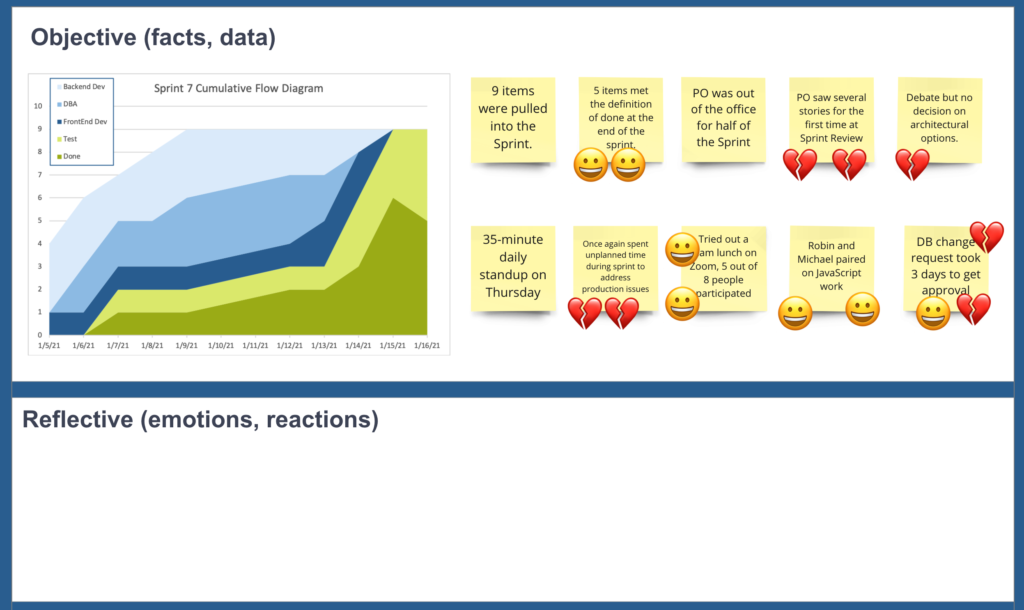
Sample for how the board might look after the Reflection step
Interpretation
The interpretation phase can go in several different directions. Your intuition as the facilitator is important here.
In its simplest form, the interpretation phase of this retro can be the facilitator asking a question like, “What meaning or patterns do you see here?” and the group doing “say it then write it.”
Alternatively, the facilitator can start there but make it more conversational, asking follow up questions, and then capturing themes on stickies as they emerge. This approach is good for converging towards a shared interpretation, but only if the follow-up questions are good and only if the group feels like the facilitator accurately captures the themes. Participants can become disengaged if they don’t feel heard.
Another approach is to ask more tightly focused questions. For example,
“What patterns do you see in the smileys? How about the broken hearts?”
“What seems to help us maximize impact and ease in our work? What seems to be getting in the way?”
“What does this data tell us about us and our values?”
“How are we different now than the last time we did a retrospective?”
“How might an objective outsider interpret this data? What would they see that we’re missing? What would they ask about?”
Don’t limit yourself to these. But don’t ask all these questions, either. Use your intuition to probe areas that seem important to the team.
Again, capture themes on stickies, taking care to ensure you’re accurately reflecting what the group is saying. If you want to rephrase something someone said, ask permission and let them own the outcome.
Sometimes, this phase naturally converges to one or two core ideas. Other times, it diverges into many different themes. In the latter case, have the group dot vote on this question: “What’s the most important theme for us to focus on in the next sprint?”
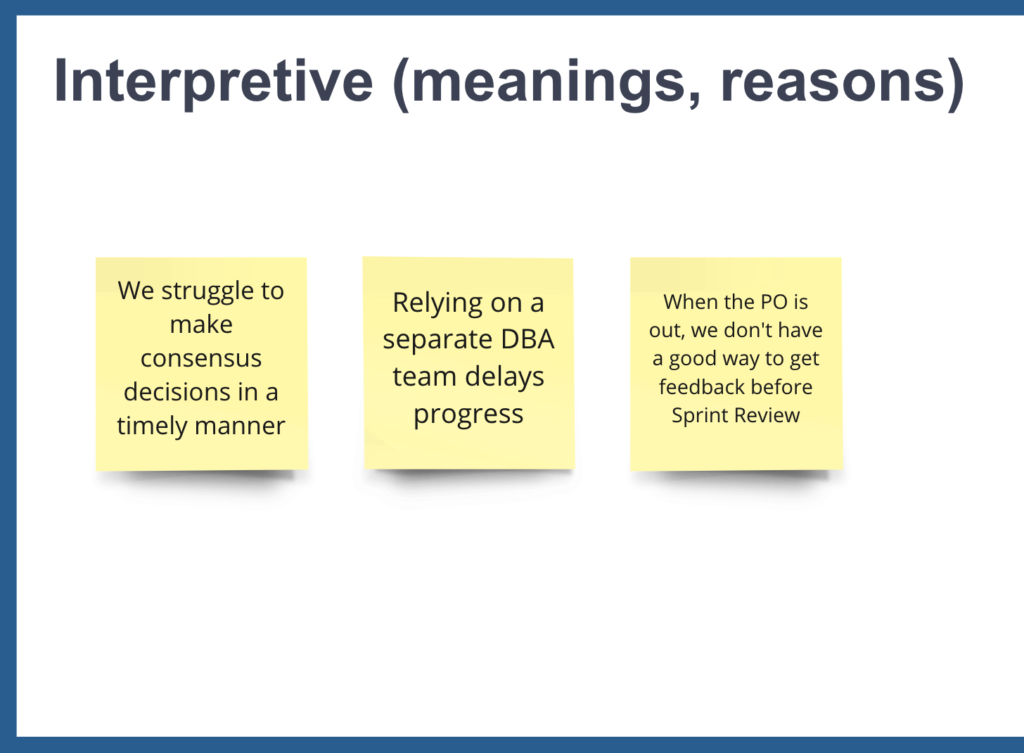
Decision
Invite proposals for experiments that could help with the selected theme. Capture them on sticky notes. If necessary, dot vote to find the one that seems most promising to the group.
Make sure the outcome gets captured in an actionable way. (Review the “Where Retrospective Outcomes Go” section of the Use the ORID Pattern lesson, part of the full course.)
Buy Now To Unlock Full Course ($200 off for a limited time)Closing
Close strong, thanking the team for their participation. (Visit the Close Strong lesson in the full course version.)
We hope you have enjoyed this sample lesson. It is one of 28 lessons in our Facilitating Effective Retrospectives with Miro course. To learn more about the course, click here.
To purchase the full course at a $200 discount, click the button below!